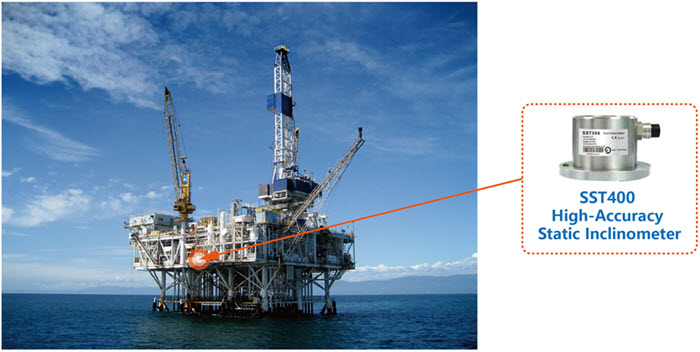Application Cases
Application of Inclination Sensor in Health Monitoring of Offshore Drilling Platforms
Currently, oil and gas exploration is gradually transferred from land to ocean. Therefore, drilling engineering operations must also be carried out in the vast ocean. In offshore oil and gas drilling construction, hundreds of large rigs must have sufficient support and space for placement, and there must have enough space for drilling personnel to live. As the main equipment for offshore oilfield development, the offshore platform accounts for about 70% of the total investment in offshore oil exploration. Once an accident occurs, it will not only bring about major economic losses and personnel injury, but also bring about adverse social and political impacts as well as bad ecological effects.

The Necessity of Health Monitoring for Offshore Drilling Platforms
The offshore drilling rig is of large weight and complex structure, and it is of long-term usage in harsh corrosive environmental conditions. The underwater part of its structure is subject to long-term erosion by seawater and marine organisms, freeze-thaw damage, alkali aggregate reactions and chemical invasions, foundation erosion as well as other environmental loads, so the bearing capacity of the structure is reduced over time. In particular, the platform durability caused by corrosion damage of steel structures has become a prominent catastrophic problem. Incidents such as tsunami, typhoons, fires, and explosions of natural gas leaks happen occasionally, which greatly threatened the normal use and durability of the platform. The offshore working environment and the internal structure are complex, besides, the online rescue is difficult, and so the reliability and stability of the offshore drilling platform is very important.

Tilt Accidents of Offshore Drilling Platform
On September 7th, 2010, the No.3 platform of the Dongying Shengli Oilfield Operation in Shandong Province, China, was tilted by 45°. This drilling platform was located at 5 nautical miles from the Dongying coast, and the water depth is 7 meters. In this tilt accident, 36 people on the platform were in distress and 2 of them fell into the water.
In December 5th, 2012, a failed braking system had caused the oil rig at Jurong Shipyard (Singapore) to tilt to one side, sending about 1,000 workers scurrying to safety and injuring 89 people.
In December, 2018, an oil rig off the coast of Andhra Pradesh operated by the Oil and Natural Gas Corporation Limited (ONGC) had tilted dangerously due to the effect of Cyclone Phethai which made landfall in the state…
Due to the variability of offshore climates, the destruction of offshore winds and undercurrents, the stability and safety of offshore drilling units is even more important. An effective monitoring and management system will help the operators to manage and maintain the offshore drilling platform efficiently. And the above offshore drilling platform accidents reflect the great necessity for a scientific monitoring system.

Application of Vigor SST400 in Health Monitoring of Offshore Drilling Platforms
The inclination state and the displacement of the offshore drilling platform can be measured by the SST400 inclination sensor. The stability monitoring is realized by continuous data collection of displacement, inclination angle, pressure, temperature and etc., and early warning is performed according to the set threshold to prevent overturning.
SST400 high precision inclinometer, which is independently designed, developed and manufactured by Vigor Technology, has a comprehensive absolute precision of ±20". Once it has been installed on the support column, it can measure the tilt angle caused by sea wind, undercurrent or platform load change in real time, so that the operator can get the inclination angle of offshore drilling platform in time. At the same time, corresponding protective tests can be carried out to minimize the occurrence of accidents. The special subsea design ensures the normal working performance when it is using on offshore drilling rig.
Categories
Applications
- Inclinometer Sensors for Dam Health Monitoring And Dam Deformation Monitoring
- TMS Intelligent Transmission Tower Safety Monitoring System Solution
- Applications of Vigor Sensors in Wind Turbine Installation and Health Monitoring
- Communication or Telecom Tower Safety Monitoring Solution with Inclinometers and Sensors
- Application of Inclination Sensor on Telescopic Handler for Tilt Monitoring
Contact Us
Contact: Vigor Technology
Phone: +86 18017387742
Tel: +86 021-58404921
E-mail: sales@vigordigital.com
Add: Block H1, No. 161, Lane 3188, Xiupu Road, Pudong New District, Shanghai